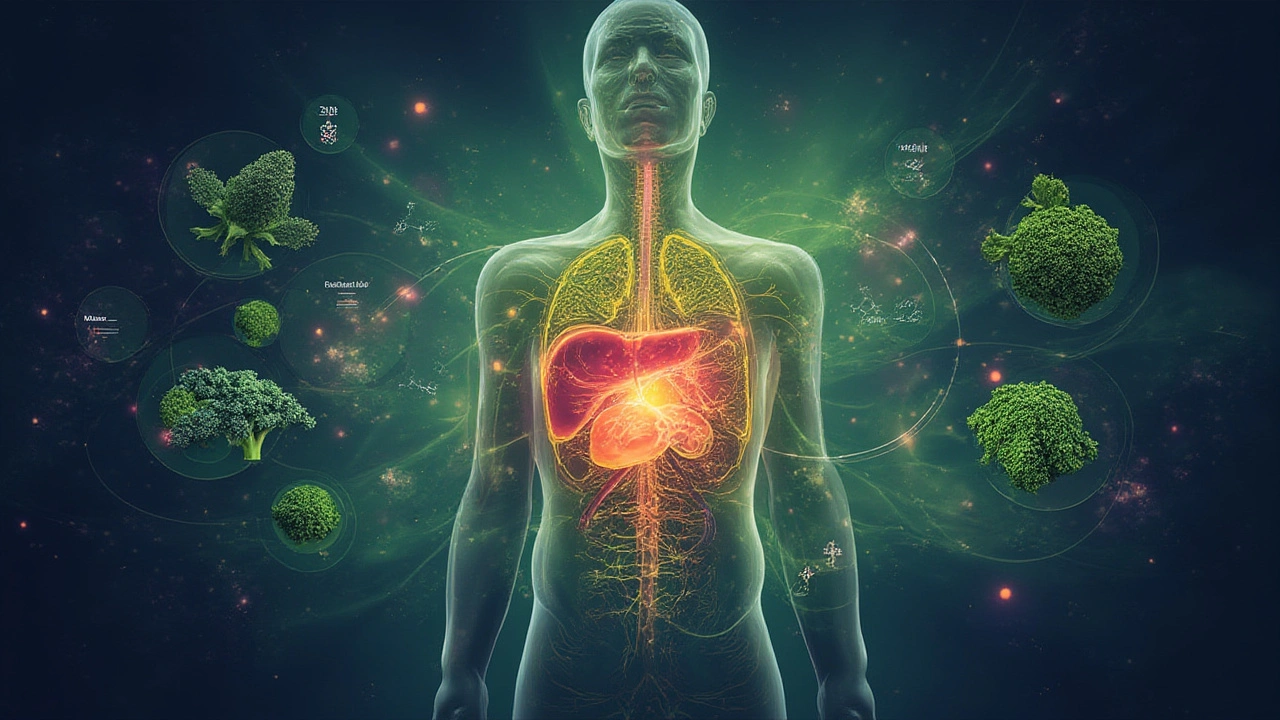Cruciferous Vegetable Extracts: Powerful Broccoli, Kale & Cabbage Detox Benefits
 Jul, 18 2025
Jul, 18 2025
Ever think your everyday broccoli or kale salad is just a way to fill up on greens? There’s way more to these vegetables than meets the eye. Inside these crunchy stalks and leafy bunches hide unique natural compounds that put in some serious work for your liver. The liver acts like the body’s chemical processing plant—breaking down toxins, hormones, and even the leftovers from your midnight pizza. And cruciferous vegetables have your back when it comes to keeping that plant running smooth. The weird part? Most people have no idea what’s going on under the surface. Let’s get into the nitty-gritty science behind why your liver loves these veggies, beyond the old “it’s good for you” cliché.
How Cruciferous Vegetables Boost Liver Detox
Cruciferous veggies like broccoli, kale, and cabbage aren’t just another nutrition trend—they have a real, studied effect on how the liver works. The big names you’ll hear are glucosinolates, sulforaphane, and indole-3-carbinol. Broccoli’s famous for sulforaphane, which comes alive when you cut, chew, or cook the vegetable (thanks to an enzyme called myrosinase). This compound turns on powerful detox enzymes inside the liver. It basically flips the switch for your body’s own natural cleaning crew, making it kick into high gear.
Kale and cabbage come loaded with their own glucosinolates, too, which, according to a 2021 review published in Molecules, have a big say in how the liver processes and removes toxins. What’s surprising? It’s not all about the raw form—light steaming or sautéing can boost the power of these compounds, breaking down cell walls and making glucosinolates easier for your body to work with.
One underrated superstar is indole-3-carbinol. When you eat these veggies, the stomach acid shapes glucobrassicin into this special compound. Indole-3-carbinol helps your liver handle estrogen and other hormones, making it an ally not just in standard detox, but in hormone-related symptoms. People sometimes look up supplements to get higher doses—products like cruciferous vegetable extract—but even food sources can add up over time for a gentle daily effect.
Want proof these compounds make a difference? There are a bunch of small but legit clinical trials. One study in the Journal of Nutrition in 2020 showed people who ate 3–5 servings of broccoli per week had higher levels of phase II detox enzymes. Participants cleared certain toxins from their blood more effectively than people who didn’t touch broccoli. Kale’s similar: diets high in kale increased antioxidant status and liver detox markers in as little as four weeks. Regular cabbage fans in Korea show statistically lower rates of some toxin-related cancers, thanks in part to these compounds ramping up liver activity.
Here’s a table to wrap your head around the basics:
| Veggie | Main Compound | Detox Effect |
|---|---|---|
| Broccoli | Sulforaphane | Activates phase II detox enzymes, boosts glutathione production |
| Kale | Glucobrassicin (converts to indole-3-carbinol) | Promotes estrogen metabolism, supports hormone detox |
| Cabbage | Sinigrin (another glucosinolate) | Enhances toxin elimination, reduces oxidative stress |
Interesting Science Behind Broccoli, Kale, and Cabbage Compounds
So, what’s actually happening at the cellular level? Under the microscope, compounds in cruciferous vegetables act almost like a training coach for your detox system. Sulforaphane “talks to” Nrf2, a protein inside your cells. When Nrf2 wakes up, it sends out the order for detox genes to get busy—there’s real gene expression at stake here. That’s part of the reason researchers in the UK called broccoli inclusion “epigenetic nutrition.” No exaggeration.
Broccoli’s reputation for cancer-fighting comes from this same pathway. When these detox enzymes go up, your liver deals better with things like benzene (car exhaust), aflatoxins (certain mold contaminants), and acetaminophen (basic painkillers). Sulforaphane is also a big anti-inflammatory agent. For people dealing with ongoing inflammation (think chronic stress, pollution exposure, even that hangover), these compounds help the liver manage the overload and keep your system from going haywire.
The hormone angle is best seen with indole-3-carbinol from kale and cabbage. Getting this in your diet boosts the ratio of “good” to “bad” estrogen metabolites, lowering the risk factors tied to hormone-driven cancers. There’s also early data saying it might slow down the ongoing damage behind non-alcoholic fatty liver disease. When people talk about “hormone balance,” it isn’t just a buzzword—a clinical trial in Japan showed that supplementing with indole-3-carbinol improved estrogen detox markers by 20% in premenopausal women in just eight weeks.
Cabbage’s sinigrin and its conversion to allyl isothiocyanate are anti-microbial and protective against certain parasites, giving your liver fewer invaders to deal with in the first place. This kitchen staple actually shields your body from environmental junk, not just by boosting your liver but by neutralizing some toxins directly in the gut. That means less work for your detox organs right from the start. When you swap out iceberg lettuce for cabbage in a salad, you’re making a choice that matters at the cellular level.

Getting the Most Out of Cruciferous Vegetable Extracts in Your Diet
You won’t find most of these super-compounds in a plain bowl of white rice. But even when you’re not a massive veggie lover, there are easy ways to get more cruciferous magic in your daily grub. Chopping and letting them sit for 10 minutes before cooking actually boosts sulforaphane—so don’t throw chopped broccoli straight into a boiling pot. Try lightly steaming instead of boiling your greens, as research out of Johns Hopkins shows up to 50% more sulforaphane is retained with steam versus high-heat boiling.
Kale chips, broccoli slaw, or a quick stir-fried cabbage are all smart options. For anyone who dreads chewing through greens every meal, supplement extracts are the major workaround. That’s where products like cruciferous vegetable extract come in. These concentrates can deliver a standardized dose of the detox players, especially indole-3-carbinol and sulforaphane, in just a capsule. But don’t ditch the real foods—extracts fill the gap, but the whole veggies bring fiber, vitamins C and K, and a deeper flavor that supplements just can’t match.
- Pick baby kale or broccoli sprouts—they have up to 20x the sulforaphane content of mature plants.
- Rotate all three: mix broccoli, kale, and cabbage so your liver gets a wider nutrient range.
- Pair with spices like turmeric or black pepper for even better absorption.
- Make sure not to microwave cruciferous veggies every time—it’s the one cooking method that drops their protective compounds the lowest.
Some people feel a gentle “lift” or lighter feeling after a few weeks of adding more cruciferous vegetables. That’s the liver getting a break from its regular grind, no detox teas or crash cleanses needed. Actual results may take 2–4 weeks, depending on how overloaded your system is to start.
Pro Tips and Surprising Facts for Daily Liver Care
If you want real, sustainable detox—not just a quick fix—start looking at your daily habits. Cruciferous vegetables aren’t just a one-hit-wonder: they teach your liver to handle everyday exposures, whether it’s city air, desk job stress, or weekend barbecues. Most health experts now recommend at least 1–2 servings daily, but don’t stress if you miss a day. Consistency over time is what retrains your body’s systems.
Worried about thyroid issues? Eating raw cruciferous in massive amounts can slow down thyroid hormone if you’re very low in iodine, but there’s no concern for most people who eat a moderate, diverse diet. Cooking deactivates this effect almost entirely, so steamed broccoli or stir-fried kale is safe for nearly everyone.
Watch for possible bloating—sometimes the fiber and fermentable sugars cause a little rumble, especially if your gut isn’t used to them. Start small, build up, and you’ll adapt. A cup of broccoli, two leaves of kale in a smoothie, and some cabbage in your tacos—it all counts. If you’re serious about dialing up your liver support, combine these foods with regular movement (even just a daily walk), enough water, and less junk food. Your liver works best when it isn’t drowning in sugar, fat, or processed stuff, so every little swap helps.
One last fact: scientists at Oregon State found sulforaphane levels in people can vary tenfold, even with the same serving of broccoli. Your gut bacteria shape how you process these goodies, so keep gut health in mind too. Maybe an occasional probiotic or some yogurt will help you get even more out of your greens.
If you want a shortcut to the real science, focus on the cruciferous vegetable extract benefits, but don’t underestimate the power of having a few fresh servings on your plate each week. Your liver doesn’t take days off—and with this daily dose of greens, neither does your internal cleanup crew. Now you know what those leafy bunches are really doing for you—better detox, sharper hormone balance, and a liver that actually keeps up with your lifestyle.